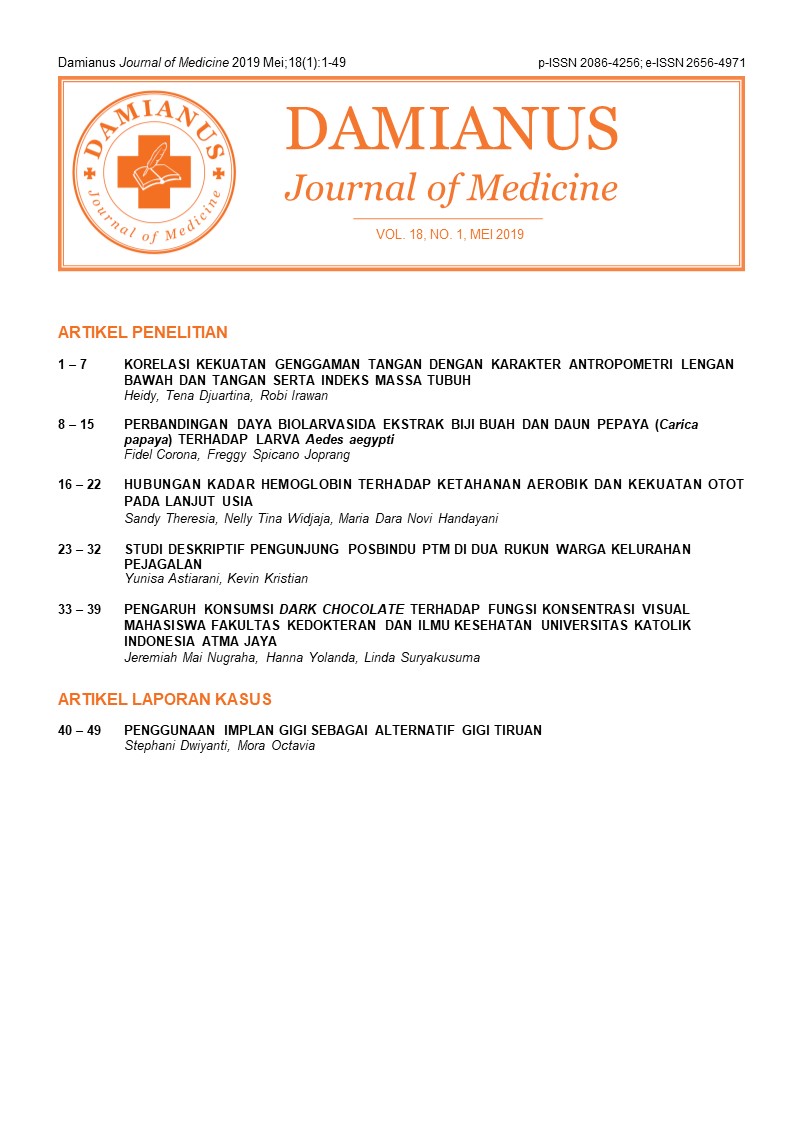A DESCRIPTIVE STUDY OF COMMUNITY HEALTH POST VISITORS IN TWO HAMLETS IN KELURAHAN PEJAGALAN
DOI:
https://doi.org/10.25170/djm.v18i1.2202Keywords:
community health, health program, non-communicable diseases/NCDs, posbindu, hypertension, diabetes.Abstract
Introduction: A community-based health post called ‘pos pembinaan terpadu’ (Posbindu) is a vital approach to NCDs prevention and control strategy in the community. However, the posts appear to receive low appreciation in urban areas, with less than 10% of the population at risk visiting the post. This study presented a descriptive evaluation in Posbindu visitors after half-year implementation in two hamlets in Pejagalan.
Methods: A survey-based study was conducted in two Posbindu, each in a hamlet. A self-questionnaire regarding sociodemography, NCDs status, risk factors, visiting frequency and health-seeking behaviour were asked to all visitors and collected during Posbindu schedule.
Results: Posbindu visitors in hamlet A and B (131 and 160) share common demographic characteristics, with women participation higher in both (Hamlet A= 90.1% and Hamlet B=80.6%) mostly in their 30-44 age group for hamlet A (38.9%) and 45-59 age group for hamlet B (50%). Homemakers and unemployed were more than 70% of the proportion with low education preceding (40%) in both hamlets. NCDs status slightly higher in hamlet A (54.1%) than in B (53.7%), with hypertension, occupied the most. More than 90% of visitors lack in physical activity. Health seeking behaviour is better in diabetes sufferer than hypertension.
Conclusion: Posbindu visitors are usually housewives or unemployed group due to limitation of schedule. School and workplace-based NCDs prevention program have to be in consideration. Open space facilities on increasing the community's physical activity and intensive health literacy are necessary to maintain their healthy life years.
Downloads
References
Bennett JE, Stevens GA, Mathers CD, Bonita R, Rehm J, Kruk ME, Riley LM, Dain K, Kengne AP, Chalkidou K, Beagley J. NCD Countdown 2030: Worldwide trends in non-communicable disease mortality and progress towards Sustainable Development Goal target 3.4. TheLancet. 2018 Sep 22;392(10152):1072-88.
Nugent R. A chronology of global assistance funding for NCD. Global heart. 2016 Dec 1;11(4):371-4.
Norheim OF, Jha P, Admasu K, Godal T, Hum RJ, Kruk ME, Gómez-Dantés O, Mathers CD, Pan H, Sepúlveda J, Suraweera W. Avoiding 40% of the premature deaths in each country, 2010–30: review of national mortality trends to help quantify the UN Sustainable Deve-lopment Goal for health. The Lancet. 2015 Jan 17;385(9964):239-52.
Kesehatan, Kementrian. Riset kesehatan dasar (Riskesdas). Kemenkes RI. 2018.
Dinas Kesehatan Provinsi DKI Jakarta. Profil kesehatan provinsi DKI Jakarta tahun 2017. Dinas Kesehatan Provinsi DKI; 2018.
Menular DP, Indonesia KK. Petunjuk teknis pos pembinaan terpadu penyakit tidak menular (posbindu PTM). Jakarta: Kemenkes RI. 2012.
Kementerian Kesehatan RI. Peraturan mente-ri kesehatan Republik Indonesia nomor 5 ta-hun 2017 tentang rencana aksi nasional pe-nanggulangan penyakit tidak menular. Jakar-ta: Kementrian Kesehatan RI; 2017. p. 67.
Rivai L, Soewondo P, Irawati D. Pelayanan penyakit tidak menular terpadu (PANDU) sebagai adaptasi World Health Organization (WHO) package essential of noncommuni-cable diseases intervention (PEN) di fasilitas pelayanan primer. J Indon Med Assoc. 2015;593–5.
Penyakit DP. Rencana aksi program pengendalian penyakit dan penyehatan ling-kungan tahun 2015-2019. Jakarta: Direktorat Jenderal Pengendalian Penyakit dan Penyehatan Lingkungan. 2015;
Peta Jumlah Posbindu PTM - Direktorat P2PTM [Internet]. [cited 2019 Feb 8]. Available from: http://www.p2ptm.kemkes.go.id/profil-p2ptm/informasi/peta-jumlah-pos-bindu-ptm
Tim Pelaksana XIII. Laporan pelaksanaan program pengendalian penyakit tidak menular dan pos pembinaan terpadu di Rukun Warga 013 dan 015 Kelurahan Pejagalan. Depar-temen Ilmu Kesehatan Masyarakat dan Gizi Fakultas Kedokteran Unika Atma Jaya; 2019.
Jayanna K, Swaroop N, Kar A, Ramanaik S, Pati MK, Pujar A, Rai P, Chitrapu S, Patil G, Aggarwal P, Saksena S. Designing a comprehensive non-communicable diseases (NCD) programme for hypertension and diabetes at primary health care level: evidence and experience from urban Karnataka, South India. BMC public health. 2019 Dec;19(1):409.
Hegde SK, Agrawal T, Fathima FN, Amar DS. Factors associated with health seeking beha-viour regarding non-communicable diseases among elderly in a rural community in Karna-taka (India). Indian Journal of Gerontology. 2015 Jul 1;29(3).
Sari DWR, Savitri M. Faktor-faktor yang berhubungan dengan pemanfaatan posbindu penyakit tidak menular (PTM) di wilayah kerja Puskesmas Ket Tahun 2018. Jurnal Kebijakan Kesehatan Indonesia : JKKI. 2018 Oct 22;7(2):49–56.
Thompson AE, Anisimowicz Y, Miedema B, Hogg W, Wodchis WP, Aubrey-Bassler K. The influence of gender and other patient characteristics on health care-seeking behaviour: a QUALICOPC study. BMC family practice. 2016 Dec;17(1):38.
Nugraha A, Martiana T, Indriani D. Surveillance system development based on NCD integrated post (posbindu PTM) as an effort of occu-pational health services (A study on the port health office employee of Class I Surabaya).Indian Journal of Public Health Research & Development. 2018;9(5):153-7.
Selvavinayagam TS. Screening 35 million for hypertension and diabetes mellitus through public system: experiences of Tamil Nadu, India. International Journal of Community Medicine and Public Health. 2017 Sep 22;4(10):3882-7.
Phillips SA, Martino S, Arena R. Research opportunities and challenges in the era of healthy living medicine: Unlocking the potential. Progress in cardiovascular diseases. 2017 Mar 1;59(5):498-505. 20. Badan Pusat Statistik. Profil pendidikan penduduk DKI Jakarta 2017. BPS;2017.
Rahmatulloh R. Dinamika kependudukan di ibukota Jakarta (deskripsi perkembangan kuantitas, kualitas dan kesejahteraan penduduk di DKI Jakarta). Genta Mulia: Jurnal Ilmiah Pendidikan. 2018 Jun 4;8(2).
World Health Organization. Noncommunicable diseases (NCD) country profiles, 2018. World Health Organization; 2018.
Hattori K, Uda H, Hitomi Y, Yano R, Saijo T, Watanabe N, Satomi M, Yoshida A, Oishi O, Yamashita T, Kamenosono A. The current situation and agendas in the prevention and control of non-communicable diseases in Vietnam. [Nihon koshu eisei zasshi] Japanese journal of public health. 2018;65(4):170-8.
Ibrahim MM. Hypertension in developing countries: a major challenge for the future. Current hypertension reports. 2018 May 1;20(5):38.
World Health Organization. The investment case for non‐communicable disease pre-vention and control in Barbados. World Health Organization; 2017.
Sharma A. Global research priorities for non- communicable diseases prevention, manage-ment, and control. International Journal of Noncommunicable Diseases. 2017 Oct 1;2(4):107.
Khawaja N, Abu-Shennar J, Saleh M, Dahbour SS, Khader YS, Ajlouni KM. The prevalence and risk factors of peripheral neu-ropathy among patients with type 2 diabetes mellitus; the case of Jordan. Diabetology & Metabolic Syndrome. 2018 Dec;10(1):8.
Islam SM, Niessen LW, Seissler J, Ferrari U, Biswas T, Islam A, Lechner A. Diabetes knowledge and glycemic control among patients with type 2 diabetes in Bangladesh. Springerplus. 2015 Dec 1;4(1):284.
Doulougou B, Gomez F, Alvarado B, Guerra RO, Ylli A, Guralnik J, Zunzunegui MV. Factors associated with hypertension preva-lence, awareness, treatment and control among participants in the International Mo-bility in Aging Study (IMIAS). Journal of human hypertension. 2016 Feb;30(2):112.
Gutierrez AP, McCurley JL, Roesch SC, Gonzalez P, Castañeda SF, Penedo FJ, Gallo LC. Fatalism and hypertension prevalence, awareness, treatment and control in US Hispanics/Latinos: results from HCHS/SOL Sociocultural Ancillary Study. Journal of behavioral medicine. 2017 Apr 1;40(2):271-80.
Chun H, Kim IH, Min KD. Accuracy of self-reported hypertension, diabetes, and hyper-cholesterolemia: analysis of a representative sample of Korean older adults. Osong public health and research perspectives. 2016 Apr 1;7(2):108-15.
Delima D, Mihardja LK, Ghani L. Faktor risiko dominan penderita stroke di Indonesia. Indo-nesian Bulletin of Health Research. 2016;44(1).














